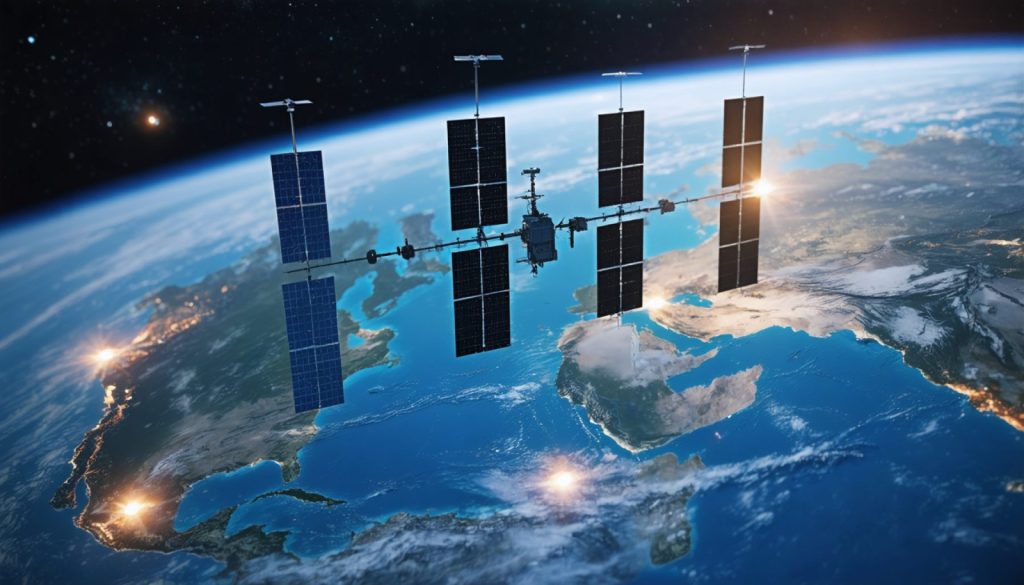
- Satellites are crucial for global communication, enabling services like television, internet, and telecommunication worldwide.
- They facilitate essential modern services, including GPS navigation, remote education, and telemedicine, bridging geographic and social gaps.
- Low Earth orbit (LEO) satellite constellations are revolutionizing connectivity by providing internet access to underserved regions.
- Satellites contribute significantly to climate science by tracking weather patterns and environmental changes, aiding disaster preparedness.
- The technology is pivotal for future advancements, such as the Internet of Things (IoT) and smart city infrastructures.
- Satellite communication exemplifies seamless technological integration, crucial for building an interconnected and innovative world.
- These advancements showcase the potential for satellites to be the backbone of global connectivity, shaping our daily lives and future.
https://youtube.com/watch?v=4Nj-TkMxTFI
High above the Earth, satellites silently orbit the planet, playing a pivotal role in the tapestry of global communication. These advanced technological marvels may be out of sight, but their impact on our daily lives is profound and constant. Today, the realm of satellite communication is transforming how we connect with each other and the world.
Imagine a digital thread weaving through the sky, linking continents and bringing far-flung corners of the globe closer together. This is not a mere fantasy; it is the reality that satellite communication brings to life. Every time you make a call from a remote location or watch a live broadcast from another country, satellites are at work, ensuring clarity and connection.
The Role of Satellites in Our Daily Lives
Satellites perform a crucial function by beaming signals for television, internet, and telecommunication. They enable services that are essential for modern living, from navigational aids such as GPS to facilitating international phone calls. These space-based platforms break through terrestrial barriers, ensuring reliable communication even in the most challenging environments.
Satellite communication’s reach extends into fields that safeguard our future. In remote education, they provide digital classrooms to those in the most isolated parts of our planet, leveling the educational playing field. In healthcare, satellite technology empowers telemedicine, connecting patients with specialists from the comfort of their homes.
Advancements and Innovations
The advent of low Earth orbit (LEO) satellite constellations marks a new era of connectivity. Unlike their geostationary counterparts, these satellites orbit closer and cover less ground individually but together form a mesh that blankets the earth. Tech giants and aerospace pioneers are investing heavily in LEO satellites to bring the internet to underserved regions, promising to bridge the digital divide once and for all.
These advancements benefit climate science as well. Satellites meticulously track weather patterns and environmental changes, offering critical data for researchers addressing climate challenges. The ability to predict storms or monitor forest health from space helps governments and communities prepare for and respond to natural disasters.
A Future Driven by Communication
As we soar into an ever-more-connected future, the omnipresence and reliability of satellite communication will remain indispensable. The technology holds great promise, from supporting the burgeoning IoT (Internet of Things) to augmenting the capabilities of smart cities. It promises to be the backbone of an interconnected, informed, and innovative world.
Satellite communication is shaping not just the way we communicate but the kind of tomorrow we will inhabit. It exemplifies the seamless integration of technology across landscapes and disciplines, offering a paradigm of progress powered by connectivity.
The next time you make a call across continents or access an online stream, picture those satellites overhead, tirelessly working to make it all possible. The sky is no longer the limit; it is the bridge that unites us all.
Unlocking the Hidden Potential of Satellite Communication: The Future of Global Connectivity
Satellites orbiting high above the Earth are vital yet often unnoticed facilitators of modern life. From enabling seamless global communication to providing essential services, satellite technology is more integrated into our daily activities than most people realize. In this exploration, we delve into both established benefits and emerging advancements in satellite communication that are poised to reshape industries and our everyday experiences.
Expanding Satellite Applications
Satellites are indispensable for far more than just broadcasting television or enabling phone calls. Here’s how they’re impacting key sectors:
1. Environmental Monitoring: Satellites are invaluable in climate science. They gather comprehensive data on weather patterns, deforestation, sea levels, and atmospheric changes, enabling researchers and policymakers to make informed decisions about environmental protection and climate resilience.
2. Disaster Response and Management: Satellites offer critical real-time data on natural disasters, such as hurricanes or forest fires, empowering emergency services to plan and respond more effectively. Their bird’s-eye perspective allows for efficient resource allocation and damage assessment post-disaster.
3. Military and Defense: In the realm of national security, satellites provide unmatched surveillance and reconnaissance capabilities. They serve as crucial tools for intelligence gathering and monitoring potential threats, maintaining global peace and security.
Advancements and Innovations
1. Growth of LEO Satellites: The deployment of low Earth orbit (LEO) satellite constellations is revolutionizing internet access globally. Companies like SpaceX and Amazon are heavily investing in creating a network of these satellites to deliver fast and reliable internet to remotest locations, aiding in overcoming geographical barriers.
2. Enhanced Satellite Tech for IoT: With the expansion of the Internet of Things (IoT), satellites play a vital role in maintaining connectivity for a growing number of devices globally, from smart household gadgets to industrial equipment, enhancing automation and efficiency in various sectors.
3. Smart Cities and Satellite Synergy: Satellites are key to the development of smart cities, where they support advanced transportation systems, energy grids, and digital infrastructures. Their ability to provide real-time data ensures that urban management is innovative, sustainable, and efficient.
Challenges and Considerations
1. Space Debris and Management: The increased number of satellites, particularly LEOs, poses the risk of space debris. Managing and mitigating this debris is crucial to maintaining operational satellites and safeguarding space as a shared resource.
2. Regulatory and Privacy Concerns: The extensive reach of satellites raises issues related to data privacy and regulation. Clear guidelines and policies are vital to ensure that satellite data is used ethically and responsibly.
Actionable Tips: Maximizing Satellite Services
– For businesses in remote areas, consider satellite internet solutions to ensure a reliable connection where traditional broadband may be unavailable.
– Utilize satellite-based GPS for advanced logistics and supply chain optimizations, ensuring timely deliveries and efficient route management.
– Engage with telemedicine services facilitated by satellite connectivity to access healthcare specialists from anywhere.
For more insights into this rapidly evolving field, explore the evolving capabilities and new applications of satellite communication in your field. Keep abreast of trends and policies that may affect how we use these technologies going forward.
For additional resources on satellite technology, visit [NASA](https://www.nasa.gov) for cutting-edge research and updates.
Satellite communication is not just the key to connectivity; it is the foundation of an ultra-connected future. As the technology continues to evolve, staying informed and prepared to leverage its potential will be crucial for businesses and individuals alike.



